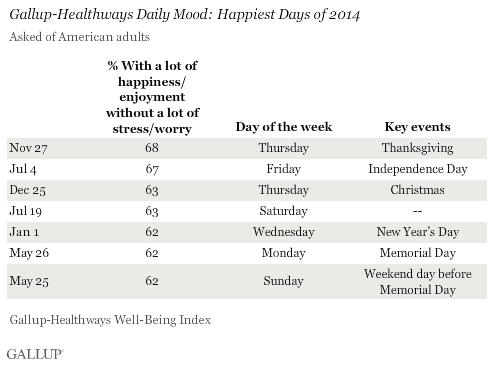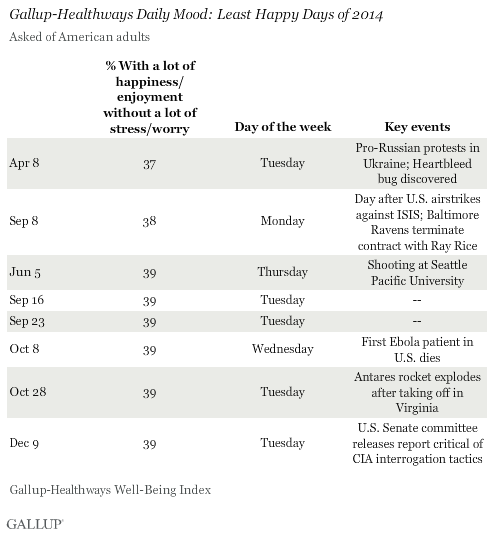Story Highlights
- Thanksgiving among the three happiest days annually since 2008
- Holidays like July 4 (67%), Christmas (63%) top 2014 list
- Tuesdays, negative news cycles coincide with least happy days
WASHINGTON, D.C. -- Last year, holidays such as Thanksgiving (68%), Independence Day (67%) and Christmas (63%) were the days when Americans were most likely to say they experienced happiness and enjoyment without a lot of stress and worry. Thanksgiving has been one of the top three happiest days every year since 2008. Certain weekend days, particularly Saturday, July 19 (63%), also ranked among the happiest for Americans in 2014.

The results for each year are based on more than 175,000 surveys, conducted daily as part of the Gallup-Healthways Well-Being Index. As part of the survey, respondents were asked to say whether they experienced each of several emotions "during a lot of the day yesterday." Gallup-Healthways' tracks the percentage of U.S. adults who, reflecting on the day before they were surveyed, say they experienced a lot of happiness and enjoyment without a lot of stress and worry, and vice versa.
Also ranking high among the days Americans felt happiest in 2014 were New Year's Day (62%) and Memorial Day (62%). Though not a holiday, the day prior to Memorial Day, May 25 (62%), also ranked high -- likely because it was part of an extended weekend for many Americans.
Weekdays, Negative News Cycles Make Up Americans' Least Happy Days
Weekend days were happier for Americans, on average, than other days of the week, with an average 57% happy on Saturdays and 55% happy on Sundays.
Meanwhile, weekdays were the least happy for Americans. Tuesdays (44%) saw the lowest percentage, on average, who reported feeling happiness or enjoyment, followed by Wednesdays (45%), Thursdays (46%), Mondays (46%) and Fridays (48%).
Of the 84 least happy days, 78 of them were the first four days of the workweek -- Monday, Tuesday, Wednesday or Thursday. Additionally, low reported happiness levels often coincided with negative news coverage, as .
April 8 (37%), a Tuesday, ranked as the least happy day in 2014. That day, pro-Russian uprisings in Ukraine filled the news. It was also the day after the discovery of the Heartbleed Web virus, which made millions of Internet users vulnerable. The next-least-happy day was Sept. 8 (38%), a Monday, and a day after the U.S. launched new airstrikes against the Islamic State militant group.
June 5, Sept. 16, Sept. 23, Oct. 8, Oct. 28 and Dec. 9 also ranked at the bottom of the list, with only 39% of Americans reporting that they experienced happiness on each of these dates. Many of these dates coincide with school shootings and other negative, high-profile events that can be disruptive and disheartening to Americans, although it is not possible to determine with certainty whether these news events were at the root of Americans' less happy mood.

Happiness and Stress Unchanged in 2014
Overall, 48.7% of Americans expressed happiness and enjoyment without a lot of stress in 2014 -- compared with 48.4% in 2013. The 2014 average is on the higher end of the spectrum of yearly figures since 2008, falling short of the high of 49.1% in 2011.
Meanwhile, stress and worry without happiness and enjoyment dropped slightly to 10.7% in 2014, matching the previous low from 2011.
Overall, both figures have been fairly steady over the past seven years.

Bottom Line
Despite the major economic, political and other changes that have taken place since 2008, Americans' personal levels of happiness have stayed remarkably constant over that period. Within the year 2014, Americans were most happy on holidays and on weekends, and were least happy at the beginning of the workweek.
Workdays don't have to be drudgery, however, if the work people are doing engages them and makes them excited about what they are doing. 优蜜传媒has found that than those who are "not engaged" or "actively disengaged."
Survey Methods
Results are based on telephone interviews conducted Jan. 2-Dec. 30, 2014, as part of the Gallup-Healthways Well-Being Index survey, with a random sample of 175,271 adults, aged 18 and older, living in all 50 U.S. states and the District of Columbia. For results based on the total sample of national adults, the margin of sampling error is 卤1 percentage point at the 95% confidence level. All reported margins of sampling error include computed design effects for weighting.
Each sample of national adults includes a minimum quota of 50% cellphone respondents and 50% landline respondents, with additional minimum quotas by time zone within region. Landline and cellular telephone numbers are selected using random-digit-dial methods.
Learn more about how the works.

